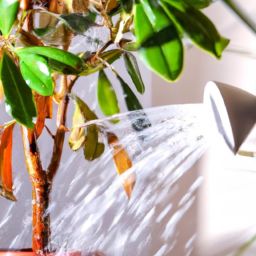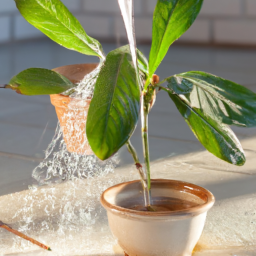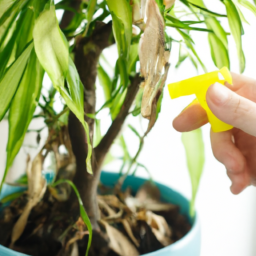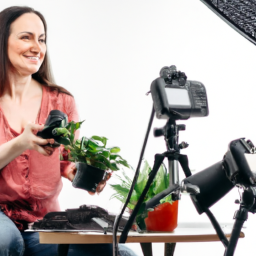
Have you ever wondered why your plant isn’t thriving despite your best efforts to care for it? One common mistake that many plant owners make is overwatering a plant. It’s easy to think that more water means better growth, but in reality, too much water can actually harm your plant. In this blog post, we’ll explore the signs of overwatering, the effects it can have on your plant, and how to prevent it from happening in the future. So if you’re struggling to keep your plant healthy, keep reading to learn more about the dangers of overwatering a plant.
Common signs of overwatering a plant
Yellowing leaves
When a plant is overwatered, one of the most common signs is yellowing leaves. This occurs because the roots of the plant are not able to absorb oxygen properly due to the excess water in the soil. As a result, the leaves start to turn yellow as the plant is unable to photosynthesize effectively. If you notice yellowing leaves on your plant, it may be a sign that you are overwatering it.
Another indicator of overwatering is the wilting of the leaves. When a plant receives too much water, the roots become waterlogged and are unable to take up nutrients effectively. This can cause the leaves to wilt and appear floppy. If you notice that your plant’s leaves are wilting even though you are watering it regularly, it may be a sign of overwatering.
In addition to yellowing and wilting leaves, overwatering can also lead to the development of root rot. When a plant’s roots are constantly sitting in water, they can start to rot and decay. This can cause the plant to become weak and susceptible to disease. If you notice that your plant is not growing as well as it should be, or if it is starting to show signs of root rot such as mushy roots, it may be a sign that you are overwatering it.
Stunted growth
Another common sign of overwatering a plant is stunted growth. When a plant receives too much water, its roots are unable to absorb nutrients effectively, which can cause the plant to stop growing. If you notice that your plant is not growing as quickly as it should be, or if it is smaller than expected, it may be a sign that you are overwatering it.
In addition to stunted growth, overwatering can also lead to the development of mold and mildew on the plant. Excess water in the soil creates a damp environment that is ideal for the growth of mold and mildew. If you notice a fuzzy white or gray substance on your plant’s leaves or stems, it may be a sign that you are overwatering it.
Furthermore, overwatering can also attract pests such as fungus gnats and root aphids. These pests thrive in moist environments and can quickly infest a plant that is being overwatered. If you notice small flying insects around your plant, or if you see tiny insects crawling on the roots, it may be a sign that you are overwatering it.
Soil moisture levels
To determine if you are overwatering your plant, it is important to check the soil moisture levels regularly. One way to do this is by sticking your finger into the soil up to the first knuckle. If the soil feels damp or wet, it is a sign that the plant does not need to be watered. However, if the soil feels dry, it may be time to water the plant.
Another method to check soil moisture levels is by using a moisture meter. These devices can accurately measure the moisture content of the soil and help you determine if you are overwatering your plant. Ideally, the soil should be evenly moist but not waterlogged. If the moisture meter indicates that the soil is too wet, it may be a sign that you are overwatering your plant.
In addition to checking the soil moisture levels, it is important to ensure that your plant is in a well-draining pot. If the pot does not have proper drainage holes, excess water can accumulate at the bottom and cause the roots to rot. To prevent overwatering, make sure that your plant is in a pot with adequate drainage and only water it when the soil is dry to the touch.
By paying attention to the common signs of overwatering and monitoring the soil moisture levels, you can ensure that your plant remains healthy and thriving. Remember, it is always better to underwater a plant than to overwater it, as too much water can be detrimental to its growth and overall health.

Preventing Overwatering Your Plants
Hello plant lovers! Today, we’re going to talk about one of the most common mistakes that gardeners make – overwatering their plants. Overwatering can lead to root rot, nutrient deficiencies, and even plant death. But fear not, with a few simple tips and tricks, you can prevent overwatering and keep your plants happy and healthy.
Understanding the Signs of Overwatering
Before we dive into prevention strategies, let’s first discuss how to identify if your plant is being overwatered. One of the most common signs of overwatering is yellowing leaves that are mushy to the touch. You may also notice wilting, drooping, or stunted growth. If you see standing water in the saucer or pot, that’s a clear indication that you’ve been overzealous with your watering.
Another clue is a musty smell coming from the soil, which indicates that the roots are sitting in waterlogged conditions. Pay attention to the weight of the pot – if it feels unusually heavy, it’s likely that the soil is waterlogged. Lastly, if you notice mold or fungus growing on the soil surface, that’s a definite sign of overwatering.
By being observant and attuned to these signs, you can catch overwatering early on and take steps to remedy the situation before it’s too late.
Choosing the Right Pot and Soil
One of the key factors in preventing overwatering is selecting the right pot and soil for your plant. Choose a pot with drainage holes at the bottom to allow excess water to escape. Avoid using pots without drainage, as they can easily lead to water buildup and root rot.
When it comes to soil, opt for a well-draining mix that contains perlite, sand, or vermiculite. These materials help to prevent water from pooling around the roots and promote good aeration. Avoid heavy, compacted soils that retain water for too long.
Repot your plants as needed to ensure that they have enough room for healthy root growth. Overcrowded roots can lead to water retention and increase the risk of overwatering.
Establishing a Watering Routine
Establishing a consistent watering routine is essential for preventing overwatering. Before watering your plants, always check the soil moisture level by sticking your finger about an inch into the soil. If it feels dry, it’s time to water. If it’s still moist, hold off on watering for a few more days.
Water your plants thoroughly but allow excess water to drain out of the bottom of the pot. Avoid letting your plants sit in standing water, as this can lead to root rot. Be mindful of environmental factors such as temperature, humidity, and sunlight, as they can affect your plant’s water needs.
Consider using a moisture meter to accurately gauge the soil moisture level and prevent overwatering. These handy tools can help take the guesswork out of watering and ensure that your plants receive the right amount of moisture.
By following these tips and strategies, you can prevent overwatering your plants and help them thrive. Remember, a little bit of water goes a long way in keeping your green friends happy and healthy!

The Effects of Overwatering on Plant Health
Understanding the Impact of Overwatering
Overwatering is a common mistake that many plant owners make, often out of good intentions to ensure their plants are well-hydrated. However, too much water can actually harm the plant rather than help it. When a plant is overwatered, the roots are unable to access oxygen, leading to root rot. This can ultimately result in the death of the plant if not addressed promptly.
In addition to root rot, overwatering can also lead to nutrient deficiencies in the plant. Excess water can wash away essential nutrients from the soil, depriving the plant of the necessary elements for healthy growth. This can manifest in stunted growth, yellowing leaves, and overall poor plant health.
Furthermore, overwatering creates a breeding ground for pests and diseases. The excess moisture in the soil attracts harmful organisms that can damage the plant and spread to other nearby plants. This can result in the need for chemical treatments to combat the infestation, further compromising the plant’s health.
Identifying Signs of Overwatering
It is important for plant owners to be able to recognize the signs of overwatering in order to take corrective action. One common indicator is wilting, which may seem counterintuitive as it is often associated with under-watering. However, overwatered plants can also wilt due to the lack of oxygen reaching the roots.
Another sign of overwatering is yellowing or browning of the leaves. This discoloration can be a result of nutrient deficiencies caused by excess water flushing out the soil’s nutrients. Additionally, the leaves may become soft and mushy to the touch, indicating that the plant is suffering from root rot.
Finally, overwatered plants may exhibit slow growth or stop growing altogether. The excess moisture in the soil can inhibit the plant’s ability to take up nutrients and oxygen, leading to stunted growth and overall poor health. It is important to monitor the plant’s growth and make adjustments to the watering regimen as needed.
Preventing Overwatering
To prevent overwatering, it is essential to establish a proper watering routine based on the specific needs of the plant. Different plants have different water requirements, so it is important to research the specific needs of each plant in your care. In general, it is best to water plants when the top inch of soil is dry to the touch.
Using well-draining soil can also help prevent overwatering by allowing excess moisture to escape more easily. Additionally, using pots with drainage holes can help prevent water from pooling at the bottom and saturating the roots. It is important to empty saucers and trays of excess water to avoid waterlogging the plant.
Regularly inspecting the plant for signs of overwatering and adjusting the watering schedule accordingly can help maintain the plant’s health. It is better to underwater than to overwater, as most plants are more resilient to drought than excess moisture. By being mindful of your plant’s water needs and taking proactive measures to prevent overwatering, you can help ensure the health and vitality of your plants.
Key Takeaways of this article
We’ve all been guilty of it at some point – overwatering our plants. It’s a common mistake that can actually do more harm than good. When we love our plants, we want to give them all the water they need to thrive, but too much of a good thing can lead to root rot and other issues.
Overwatering can suffocate the roots of a plant, preventing them from absorbing oxygen and nutrients properly. This can lead to wilting, yellowing leaves, and ultimately the death of the plant. It’s important to let the soil dry out between waterings and to pay attention to the specific watering needs of each plant. Remember, just because a plant looks thirsty doesn’t always mean it needs water right away. So next time you reach for the watering can, take a moment to assess if your plant really needs it – your green friends will thank you for it!
Common Questions and Answers:
Q1. How do I know if I am overwatering my plant?
A1. Overwatering can lead to yellowing leaves, wilting, moldy soil, and root rot. If you notice any of these signs, you may be overwatering your plant.
Q2. What should I do if I suspect I am overwatering my plant?
A2. If you suspect you are overwatering your plant, allow the soil to dry out before watering again. Make sure the pot has proper drainage to prevent water from pooling at the bottom.
Q3. How often should I water my plant to avoid overwatering?
A3. The frequency of watering depends on the type of plant, its size, and the environment it is in. Generally, it is best to let the top inch of soil dry out before watering again.
Q4. Can overwatering be reversed if caught early?
A4. Yes, if overwatering is caught early, you can save your plant by adjusting your watering schedule and allowing the soil to dry out. Trim any affected roots or leaves to promote new growth.
Q5. What are some tips to prevent overwatering in the future?
A5. To prevent overwatering, use a moisture meter to check the soil’s moisture level before watering. Make sure the pot has drainage holes, use well-draining soil, and avoid watering on a strict schedule.

Lisa Chen is a seasoned indoor gardening expert and the author of several bestselling books on the topic. With a background in horticulture and urban farming, Lisa is dedicated to helping urban dwellers embrace the joys of cultivating green spaces indoors. Her detailed guides and hands-on tips empower readers to transform their living spaces into thriving plant sanctuaries.


